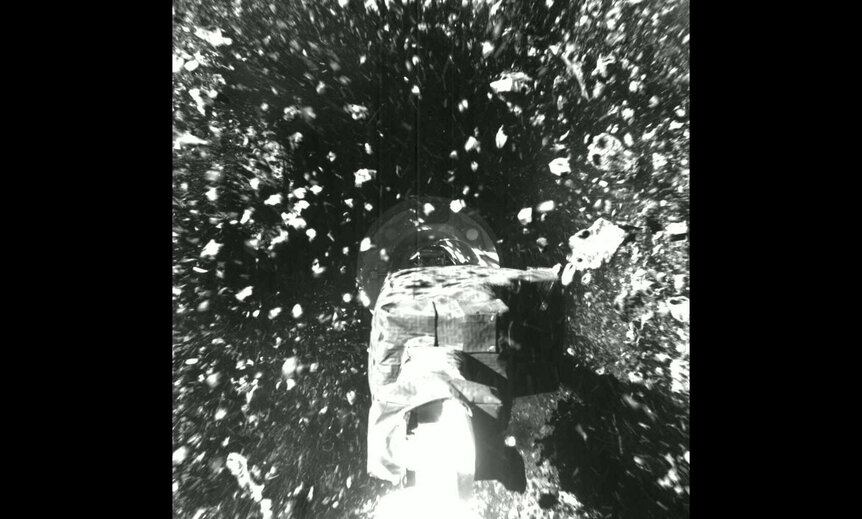Create a free profile to get unlimited access to exclusive videos, sweepstakes, and more!
BOOP! NASA spacecraft OSIRIS-REx pokes an asteroid and collects the debris

On Tuesday, 20 October 2020, the OSIRIS-REx* spacecraft booped the asteroid Bennu.
After orbiting the tiny half-kilometer wide asteroid for nearly two years, it dropped slowly down the surface, aiming at a spot on the surface nicknamed Nightingale, a relatively clear area the size of a double-wide parking area surrounded by boulders as big as the spacecraft itself.
Its Touch-And-Go Sample Acquisition Mechanism (TAGSAM) extended on the end of a long arm, contact with the surface was made by the dinner-plate sized head of the device. About one second later blasts of nitrogen gas were emitted, stirring up the small surface rocks, which flew off the asteroid like shrapnel from an explosion in the extremely low gravity. Smaller bits, though, were guided by the gas into a collector in the head. A few seconds after that, the spacecraft thrusters fired, backing it away at a zippy 40 centimeters per second (0.9 mph, basically a shuffle).
According to the scientists on the ground, the maneuver went perfectly. It's not known how much material was gathered, but that will be measured soon (by spinning the spacecraft slowly and measuring what's called its moment of inertia; the captured material at the end of the extended TAGSAM arm changes the mass distribution of the spacecraft which depends on the mass collected).
This was a phenomenally complex series of maneuvers, and it apparently went off without a hitch. Mind you, this all happened in a preplanned set of maneuvers while the spacecraft was over 330 million kilometers from Earth. The specs were to be within 25 meters of the sample site, and they nailed it to within a meter. Amazing.
This is the third time material from an asteroid has been collected. The first Japanese Hayabusa probe didn't work as planned but still collected some 1500 grains of material from the asteroid Itokawa that were returned to Earth in 2010. The second, Hayabusa2, has collected samples from the asteroid Ryugu, and those are coming to Earth in December of this year.
The purpose of this procedure is to understand better the bizarre composition of asteroids. Small ones like Bennu are rubble piles, literally loose collections of rocks held together by their mutual (and very weak) gravity. It's likely that asteroids like these used to be more solid, but impacts broke them apart. The impacts disrupt them, but just barely, and they recollect slowly via gravity to reform as one asteroid, though made up of countless smaller rocks.
Bennu's surface was found to be far more rugged than expected once OSIRIS-REx got there. The spacecraft mapped the surface from afar and up close — to get as much scientific data as possible, of course, but also to look for places where it could drop down and get a sample. Nightingale became the primary target, located in a 20-meter crater near the asteroid's north pole. It has a lot of accessible fine-grained material, just what was needed for the mission.
The footage of the TAG was amazing. The sampling head came down on a largish rock about 20 cm wide, which crumpled under the force. Now mind you, it's not like OSIRIS-REx came screaming in like a battering ram. It was moving slowly, so the rock must have been extremely fragile (what scientists call friable; crumbly). That right there is very interesting; it shows that at least some of the surface rocks are themselves incredibly delicate, likely from impacts.
If the sample collection turns out not to contain enough material, the maneuver can be done again, possibly at the backup site called Osprey on the equator (Bennu is named after an Egyptian bird deity tied to an origin myth, so the features on it are named after birds and creation myths as well).
If the sample is good, though, it will be packed away in a capsule stored on the body of the spacecraft. OSIRIS-REx is scheduled to leave Bennu in March 2021, taking two years to fly back to Earth. The capsule will be ejected where it will use a parachute to descend over Utah, where the team will await its landing to collect it and bring it to a lab.
That's the major point of the mission in fact: There's only so much scientific instrumentation you can pack onto a spacecraft. By getting these samples to Earth, scientists will have their whole arsenal of equipment to utilize, plus whatever they dream up in the future. The samples will be stored by NASA, and likely will be studied for decades to come.
But that's all in the future as yet. There's still much to do in the remaining 5 months OSIRIS-REx has near Bennu. Stay tuned. There's more cool fun science to come.
*The Origins, Spectral Interpretation, Resource Identification, Security, Regolith Explorer, an amazingly twisted acronym.




























